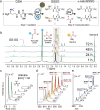Nanoparticle-Catalyzed Transamination under Tumor Microenvironment Conditions: A Novel Tool to Disrupt the Pool of Amino Acids and GSSG in Cancer Cells
- PMID: 38489158
- PMCID: PMC11010231
- DOI: 10.1021/acs.nanolett.3c04947
Nanoparticle-Catalyzed Transamination under Tumor Microenvironment Conditions: A Novel Tool to Disrupt the Pool of Amino Acids and GSSG in Cancer Cells
Abstract
Catalytic cancer therapy targets cancer cells by exploiting the specific characteristics of the tumor microenvironment (TME). TME-based catalytic strategies rely on the use of molecules already present in the TME. Amino groups seem to be a suitable target, given the abundance of proteins and peptides in biological environments. Here we show that catalytic CuFe2O4 nanoparticles are able to foster transaminations with different amino acids and pyruvate, another key molecule present in the TME. We observed a significant in cellulo decrease in glutamine and alanine levels up to 48 h after treatment. In addition, we found that di- and tripeptides also undergo catalytic transamination, thereby extending the range of the effects to other molecules such as glutathione disulfide (GSSG). Mechanistic calculations for GSSG transamination revealed the formation of an imine between the oxo group of pyruvate and the free -NH2 group of GSSG. Our results highlight transamination as alternative to the existing toolbox of catalytic therapies.
Keywords: Alanine; Amino acids; Cancer therapy; Copper; Glutamine; Glutathione; Nanocatalysis; Pyruvate; Transamination.
Conflict of interest statement
The authors declare no competing financial interest.
Figures





Similar articles
-
EORTC guidelines for the use of erythropoietic proteins in anaemic patients with cancer: 2006 update.Eur J Cancer. 2007 Jan;43(2):258-70. doi: 10.1016/j.ejca.2006.10.014. Epub 2006 Dec 19. Eur J Cancer. 2007. PMID: 17182241
-
Orthodontic treatment for crowded teeth in children.Cochrane Database Syst Rev. 2021 Dec 31;12(12):CD003453. doi: 10.1002/14651858.CD003453.pub2. Cochrane Database Syst Rev. 2021. PMID: 34970995 Free PMC article.
-
Omega-3 fatty acids for depression in adults.Cochrane Database Syst Rev. 2015 Nov 5;2015(11):CD004692. doi: 10.1002/14651858.CD004692.pub4. Cochrane Database Syst Rev. 2015. Update in: Cochrane Database Syst Rev. 2021 Nov 24;11:CD004692. doi: 10.1002/14651858.CD004692.pub5. PMID: 26537796 Free PMC article. Updated.
-
Tumor therapy by targeting extracellular hydroxyapatite using novel drugs: A paradigm shift.Cancer Med. 2024 Feb;13(3):e6812. doi: 10.1002/cam4.6812. Epub 2024 Jan 18. Cancer Med. 2024. PMID: 38239047 Free PMC article.
-
Cost-effectiveness of using prognostic information to select women with breast cancer for adjuvant systemic therapy.Health Technol Assess. 2006 Sep;10(34):iii-iv, ix-xi, 1-204. doi: 10.3310/hta10340. Health Technol Assess. 2006. PMID: 16959170
Cited by
-
Recent advances in polydopamine-coated metal-organic frameworks for cancer therapy.Front Bioeng Biotechnol. 2025 Apr 1;13:1553653. doi: 10.3389/fbioe.2025.1553653. eCollection 2025. Front Bioeng Biotechnol. 2025. PMID: 40291560 Free PMC article. Review.
References
-
- Perez-Lopez A. M.; Rubio-Ruiz B.; Sebastian V.; Hamilton L.; Adam C.; Bray T. L.; Irusta S.; Brennan P. M.; Lloyd-Jones G. C.; Sieger D.; Santamaria J.; Unciti-Broceta A. Gold-Triggered Uncaging Chemistry in Living Systems. Angew. Chem., Int. Ed. Engl. 2017, 56 (41), 12548–12552. 10.1002/anie.201705609. - DOI - PMC - PubMed
-
- Liang T. X. Z.; Chen Z. W.; Li H. J.; Gu Z. Bioorthogonal catalysis for biomedical applications. Trends in Chemistry 2022, 4 (2), 157–168. 10.1016/j.trechm.2021.11.008. - DOI
Publication types
MeSH terms
Substances
LinkOut - more resources
Full Text Sources
Medical

